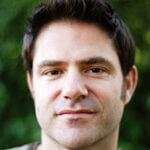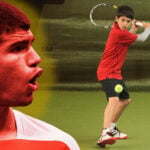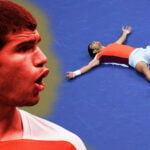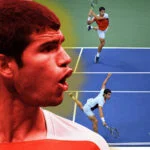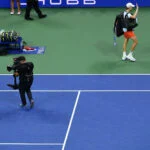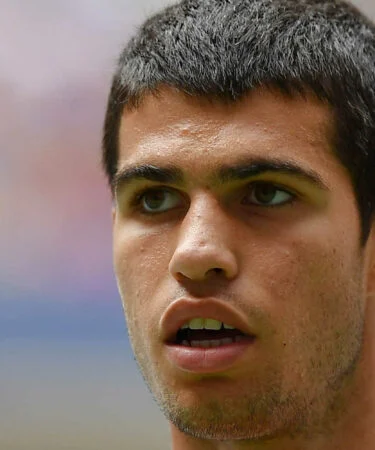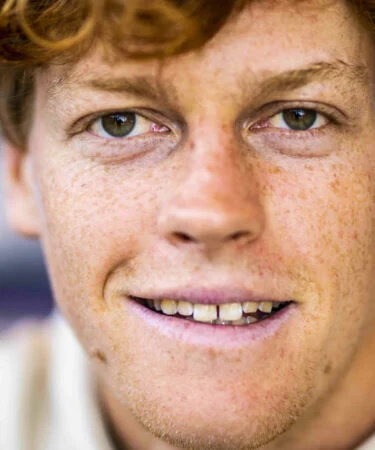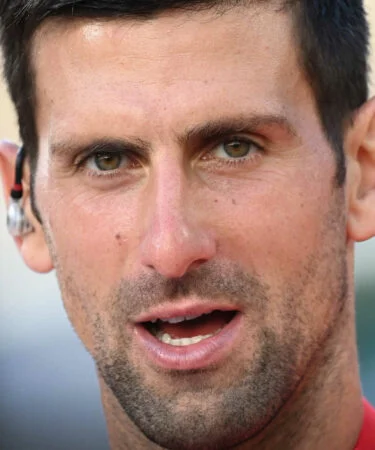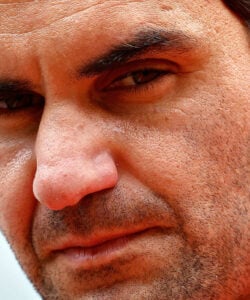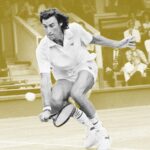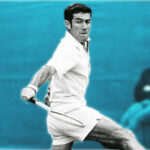Alcaraz v Sinner, the US Open quarter-final that may have shaped our next decade of tennis
In 2022, Tennis Majors published a six-part series on Carlos Alcaraz’s rise to the top. His emerging rivalry with Jannik Sinner was already being viewed as the foundation for the future of tennis. Time for a replay!
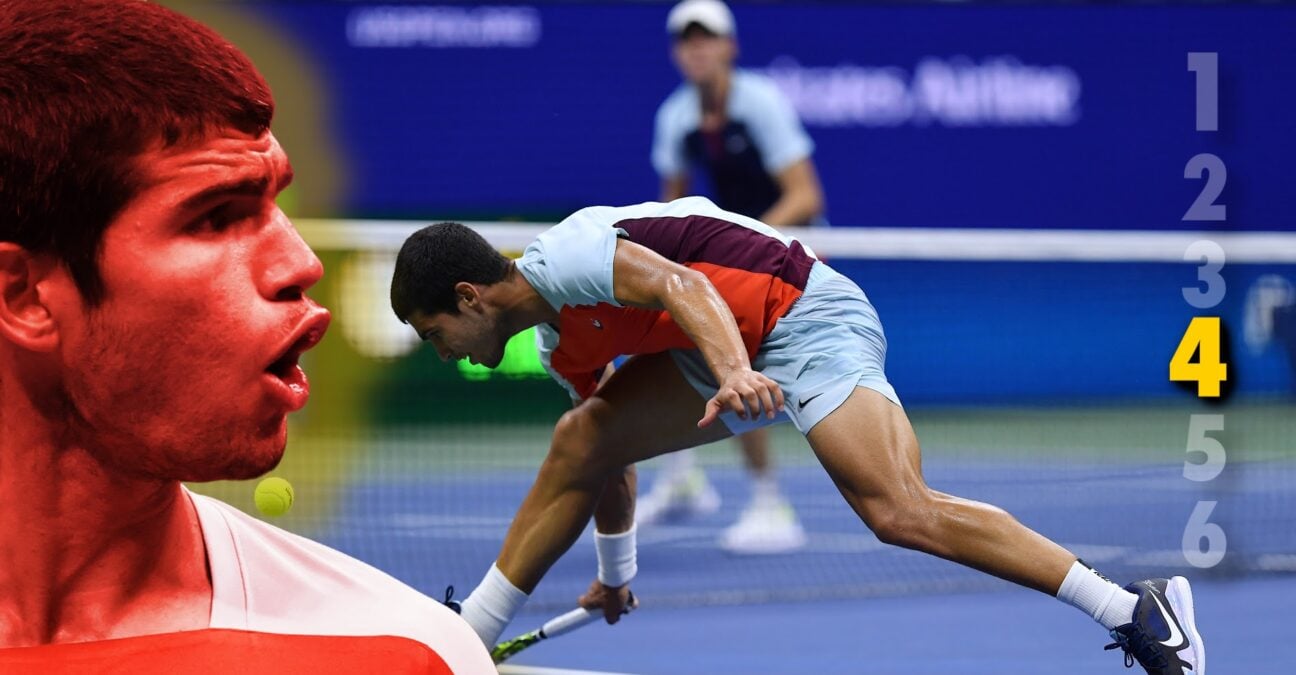 From Carlitos to Alcaraz, episode 4 © Antoine Couvercelle / Panoramic
From Carlitos to Alcaraz, episode 4 © Antoine Couvercelle / Panoramic
At the US Open in 2022, Carlos Alcaraz and Jannik Sinner played out a sensational quarter-final that gave us a glimpse of what tennis might be like on the men’s side over the next decade. Two years on, as the pair get set for a blockbuster clash in the semi-finals at Roland-Garros, we update our special feature on that match, looking back at what people saw then and how the pair are setting the standard for others to follow.
Shortly after seeing his young charge win the first of what is likely to be many Grand Slam titles at the US Open in 2022 (he’s already added a Wimbledon title since), Juan Carlos Ferrero revealed something fascinating about Carlos Alcaraz and Jannik Sinner, the Italian who came closer than anyone to stopping him in New York, holding match point before going down in a pulsating quarter-final battle.
“The other day I said to someone in the press that maybe Sinner and Carlos could dominate the tour for maybe the next 10 years, from what I saw, the level that I saw the other day,” Ferrero said.
The standard of tennis in that quarter-final, which finished at 2.50am – a record for the US Open – was close to untouchable, which is quite a word to use, given that we’re emerging from an era when Roger Federer, Rafael Nadal and Novak Djokovic took tennis to unprecedented heights.
Alcaraz and Sinner play “video-game tennis”
After five hours and 15 minutes, Alcaraz came out on top 6-3, 6-7 (7), 6-7 (0), 5-7, 6-3. He saved a match point at 5-4 in the fourth set on Sinner’s serve, thanks to an aggressive backhand return on the second serve, which forced Sinner to net a backhand, after four hours and 18 minutes. A total of 382 points were played, many of the points played at breakneck speed, shoulder-shattering weight of shot colored with nuance, variety and touch.
The term “cosmic tennis” was coined for the 2011 US Open final between Novak Djokovic and Rafael Nadal. This Alcaraz-Nadal requires a while new tennis lexicon – challenge, accepted.
Mike James, the chief tennis analyst at Mouratoglou Analytics, who worked with Iga Swiatek in the past, describes it as “video game tennis.”
“Their court position is much more aggressive,” he says. “Alcaraz particularly turns defence into attack much quicker than the previous generations. And even more, he can go from attack to defence to attack again in the same point. The mindset of the players over the last 10-15 years was more: ‘I stay there, that’s my zone for the match.’
“Alcaraz is, for me, the most comfortable at net and excels at finding the best court position in every situation. Also he’s taking drive volleys much earlier, one metre inside the baseline instead of around the service line.
“All of that put together allows them to play the ball extremely fast from A to B.”
Ever since their first ATP-level meeting at the 2021 Paris Masters in Bercy, tennis fans have let their collective imagination run wild when it comes to the future of the Alcaraz vs Sinner rivalry.
If you have been watching, you won’t need to be cajoled…
Alcaraz – from underdog to favourite
In the early days of their rivalry, long before we had any idea of how good this match-up would be, it was Alcaraz wearing the underdog hat against his older rival. Ranked 35 at the time, the precocious Spaniard cracked 18 forehand winners to take down the ninth-ranked Sinner (who hit nine) in the pair’s first career meeting, at the Paris Masters. In the process, Alcaraz dented Sinner’s chances of qualifying for that year’s Nitto ATP Finals.
High stakes, high quality, high hopes. The first iteration of this blossoming rivalry was a mouthwatering contest that piqued the collective curiosity of the tennis world.
A good omen.
After the win, Alcaraz brushed aside the growing hype and explained to the media that he was still in the process of learning the ropes and simply happy to fight against a top-10 player who had already proven himself on tour.
“I’m still learning, gaining experience,” Alcaraz told reporters after the match. “I’m 35 [in the rankings] right now. I mean, I’m really happy for the level I’m playing right now. I hope to be in the same position as Jannik Sinner in a couple of years.”
Less than a year later, the script had been flipped…
After the US Open, Alcaraz passed Sinner (and everybody else) as he ascended to the top of the ATP rankings, but Sinner left a favourable impression in their head-to-head battles, even if Alcaraz outshone him in their biggest contest to date.
Since then, Alcaraz has added a Wimbledon title to win a second slam and obtained the No 1 ranking while Sinner has become a Grand Slam champion himself, winning in Australia at the start of 2024. Level at 4-4 in their head to heads, the Italian has demonstrated the rare ability to match Alcaraz at his best. “Let’s be honest, he was a whisker away from winning that match wasn’t he?” Nick Lester, a former ATP pro and now a renowned tennis commentator, told Tennis Majors. “It was in many ways, a toss of a coin.
A Toss of a Coin – a Flushing Meadows masterpiece
Sinner has jolted the Spaniard’s foundations four times already, notching impressive victories in 2022 over Alcaraz in the Umag final (6-7 (5), 6-1 6-1), at Wimbledon (6-1, 6-4, 6-7 (8), 6-3), in Miami in 2023 (6-7 (4), 6-4, 6-2) and most recently in Beijing the same year (7-6 (4) 6-1).
Twenty-one months older than Alcaraz but not nearly as filled out physically early on, the stringbean-thin Sinner was within a whisker of making it three victories over Alcaraz at the 2022 US Open, when the pair played what by consensus was the match of the 2022 Grand Slam season. In front of throngs of wide-eyed fans inside Arthur Ashe Stadium, the Italian pushed Alcaraz to the brink.
That he eventually fell to Alcaraz, 6-3, 6-7 (7), 6-7 (0), 7-5, 6-3, didn’t dampen anyone’s enthusiasm about the state of the rivalry – or Sinner’s chances of winning his share of future contests. All of the pair’s four matches have left the pundits dazzled and the public clamouring for more, and there is the sense that the future holds even greater vintages.
“Something of a glimpse into the future in that maybe their next big Grand Slam meeting somewhere next year, with some luck from the draw, maybe it’s a final”
Steve Flink
Flink: “It could be an established order”
Speaking at the US Open in 2022, Hall of Fame tennis journalist and author Flink saw a bright future for this dynamic duo, and speculates that the pair could hold sway over the next generation when it comes to the Grand Slam title race.
“We just don’t know,” he told Tennis Majors. “It could also end up, in a few years’ time, Carlos raking [slam titles] in and Sinner taking his share. It could be an established order, where you are seeing them win multiple Slams.”
“I feel like we saw a level from those two last night that was so extraordinary, you feel like that’s the kind of tennis that is going to take them through 10 more years of incredible heights.”
— Steve Flink
Flink, like the rest of us in Queens covering the US Open fortnight, was basking in the glory of the pair’s epic quarter-final in New York.
“I feel like we saw a level from those two last night that was so extraordinary, you feel like that’s the kind of tennis that is going to take them through 10 more years of incredible heights,” he said. “I think they gave us something of a glimpse into the future in that maybe their next big Grand Slam meeting somewhere next year, with some luck from the draw, maybe it’s a final, because that match was worthy of a final.”
Sinner and Carlos dominating the tour?
Alcaraz’s coach, former world No 1 Ferrero, sees things similarly. He singled out Alcaraz and Sinner as the two men most likely to take control of the tour.
“Of course, there’s other players like [Alexander] Zverev…Casper [Ruud], [Stefanos] Tsitsipas. They are going to be there, they are going to have opportunities to win Grand Slams for sure. But with all respect, that’s what I think,” he said, referring to his comment that the rivals would be battling it out for the next 10 years at the top.
In truth, it’s far too early to tell how the next decade of men’s tennis will shape up. We haven’t even seen the end of Nadal and Djokovic, who claimed three of the four majors on offer in 2022, before Djokovic won three slams in 2023 to surge clear at the top of the men’s all-time list with 24, two more than Nadal .

Alcaraz as Nadal, Sinner as Djokovic?
The media tries its best to resist comparing Alcaraz to 22-time Grand Slam champion Nadal, but the optics are too difficult to ignore at times. Both Nadal and Alcaraz are teenage Slam winners from Spain, both have a Tasmanian Devil aspect to their intensity and physicality, both can bend minds with their supreme movement, power and on-court charisma.
Even Nadal, never one to give in to undercooked media narratives, can’t help seeing himself in Alcaraz.
“He [reminds] me a lot of [myself] than when I was a 17 or 18-year-old kid,” he said at Indian Wells in 2022. “I think he has the passion. He has the talent and the physical components.”
When asked to elaborate on the similarities he sees between himself and Alcaraz, this was Nadal’s on-point response: “The energy. The speed on the run. The amount of passion and determination that he has to become a great champion. That’s what I see in him, no?” he said. “Looks like he’s humble enough to work hard and to understand that we, the tennis players, if we want to be great champions, the only way is to keep improving during all our careers. That’s what I tried. I really believe that he’s doing that.
“I don’t have many doubts that he will be great. He is already, by the way…”
Djokovic, meanwhile, sees pieces of himself in… Sinner’s game.
“I kind of see a little bit of myself in his game, as well, from back of the court, playing flat backhand, constantly staying on the back of the line, trying to put pressure on opponents,” he said at Wimbledon in 2023, after watching the Italian defeat Alcaraz in four sets.
Not easy for Alcaraz to destabilise Sinner
Jose Higueras, former ATP No 6 (in 1983) and one-time coach of Federer, Pete Sampras, Jim Courier and many others was among the many who came away impressed by Sinner’s performance in New York in 2022.
“I think for Carlos to destabilise Sinner is not easy,” he told Tennis Majors. “He doesn’t miss that much unless you actually force him to – he’s a very, very solid player. What I was impressed with about Sinner, especially during the match with Carlos, was his willingness to actually play a little bit more of an all-court game with more coming forward, I think probably that’s been the effect of starting his work with [recently hired coach] Darren Cahill.”
Nick Lester points out that Sinner benefits from the balance of jaw-dropping power he possesses off of both wings.
“I think the one thing with Carlos is you do have to try and get to the backhand because obviously his forehand is so big, and he likes to dictate off that wing. Sinner/s got a great two-hander. So I think if you can use the two-hander up the line that’s a big shot,” Lester explains, adding: “Sinner’s got a huge weight of shot. Let’s not mess around in terms of if you look at the pure numbers, forehand and backhand side – if you weigh those two up, this guy hits one of the biggest balls on the tour, combined.”
Mike James agrees.
“He’s taking the ball much earlier than all of the guys, his average ball speed on the two sides in the highest average on Tour,” he says. “Because of his great technique he has a good lever effect and he flows around the court very very well thanks to his footwork, his timing.”
Alcaraz-Sinner is the future; everyone will be copying them
James feels Alcaraz and Sinner have already separated themselves from the rest in terms of the way they play.
“We used to box players in categories of game style,” he says.
“Alcaraz now and Sinner and Holger (Rune) soon will be players reinventing game styles,” James says. “Being a baseliner, an aggressive baseliner, a server-volleyer doesn’t make sense with them. What they do is take time away and they are creative over and over again. They have the ability to create several patterns in one game. You can see Alcaraz four metres behind the baseline on some return games and inside the baseline the game after.
“It’s not a pattern, it’s an open mindset to create chaos for the opponent.”
James believes that the two ascendant stars may have what it takes to take men’s tennis to the next level.
“We thought we had the pinnacle of the sport with Roger, Novak, Rafa; we have another level potentially with these guys. On the junior Tour we start as well to see that. The juniors and their coach copy what they see on TV, I think that since we’ve seen Rafa play amazing defensive tennis and Roger play all-court tennis, the reality is that to have to be ready to do everything, you have to be ready to be an incredible athlete, and your concentration has to be unbelievable. You can’t be a junior aiming at being a top player and having a weakness. Andy Roddick used to have a big serve and a forehand but he had no backhand. That can’t happen nowadays.”
Sinner has room to grow as well
With two players as young as Sinner and Alcaraz, it is difficult to project what their games will look like in three to five years, but it is clear that in 2022, Sinner still had a lot of room for development, both physically and tactically. He’s done just that, adding muscle and becoming physically stronger, while also bringing in Darren Cahill to his coaching team.
“He’s challenging Alcaraz anyway, and again, if you look at Sinner and watch him play, you can see that his transitional game is very much in the developmental stage,” said Lester, at the time. “He is a player that is learning to build off his ground strokes. He has some enormous groundstrokes. He is learning to take those steps forward and understand when to come in behind them.”
Brad Gilbert, Former ATP world No 4, coach of Andre Agassi and Andy Roddick and now Coco Gauff, said in 2023 that Sinner has more room to grow than Alcaraz does in that sense.
“A lot of this stuff is to be determined,” he says. “I still think Sinner’s a couple of years away from filling out and becoming a little more physical on court. You look at Carlos and he’s already kind of physically mature. You look at Sinner and even though he’s two years older, he doesn’t look like he’s physically mature yet. So I think he has a lot of growing to do, as well.”
Lester agrees with Gilbert’s prognosis.
“I think there’s probably slightly less of a fear factor with Jannik as well,” he says. Lester believed that Sinner could also beef up his serve and work on transitioning to the net behind his groundstrokes, something he’s done in the past 12 months.
“And I think in New York, not necessarily talking about the Alcaraz match but the previous rounds, you can see that he may be six months to a year away from becoming very instinctiv,” he said at the time. “If he can just be comfortable around the net then you’ve got another layer to his game. That’s going to be huge for him, going forward.”
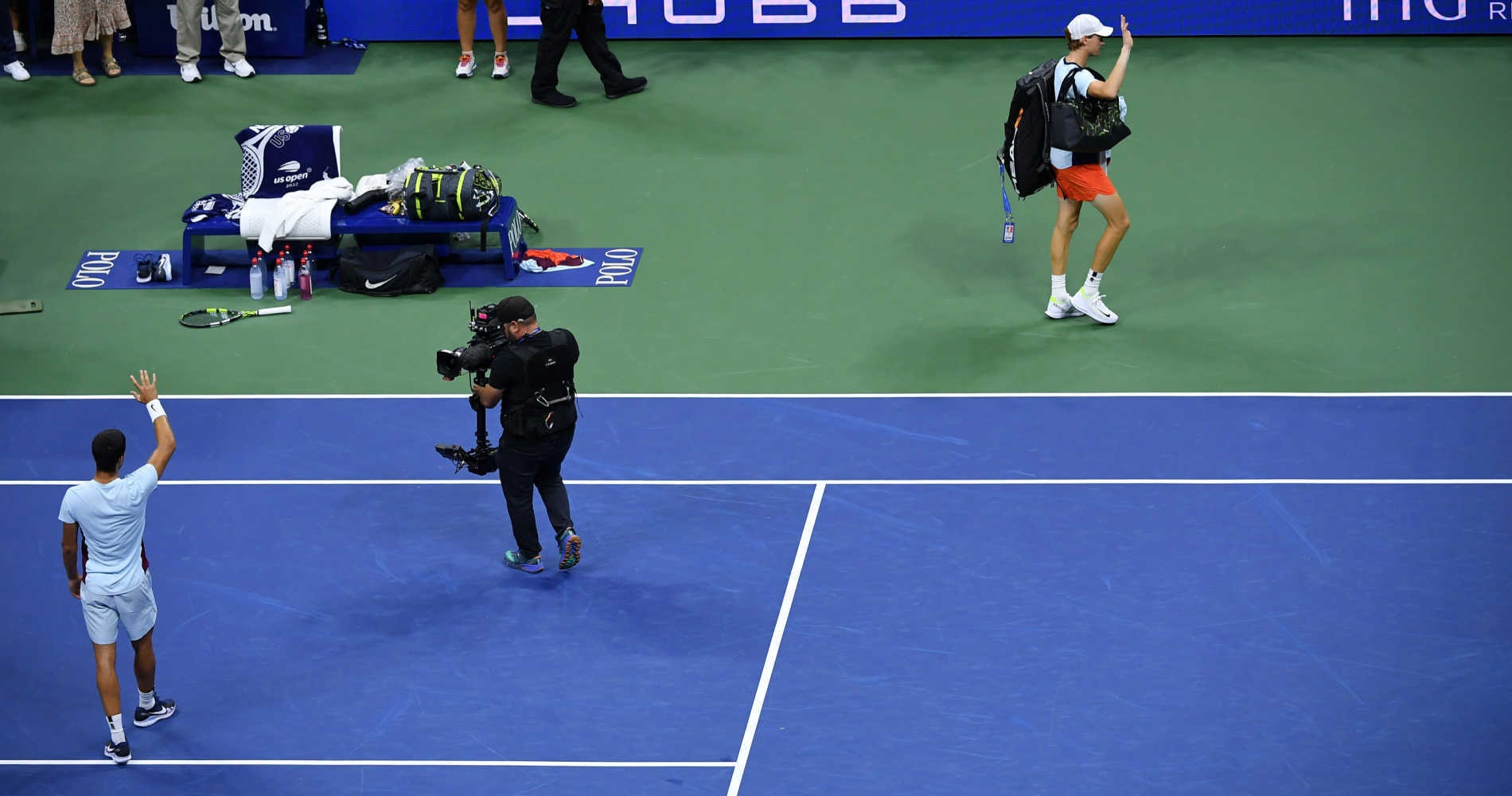
The future is bright, as is the future of Sinner v Alcaraz, no doubt about that
There is also diversity – or call it breadth – in this noteworthy matchup: Alcaraz vs Sinner is a rivalry destined to play out on all surfaces, as we have already seen in their meetings on indoor hard, clay, grass and outdoor hard. As the Big 3 era comes to close, tennis fans all over the world may have a lifeline to grab onto.
“It’s impossible to know who is going to develop that mindset and start to pull away from the others, but it was great that they set the stage for something last night in that quarter-final,” Flink said after witnessing the fourth instalment of Alcaraz v Sinner in New York.
That epic battle may not have marked the end of men’s tennis as we know it, but it certainly felt like the beginning of something big.
“Sweeping change has not happened yet but this could very well be a symbolic moment, this US Open,” Flink concludes.





